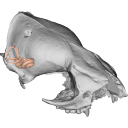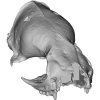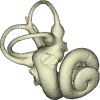3D models of early strepsirrhine primate teeth from North Africa
3D models of Miocene vertebrates from Tavers
3D models of Protosilvestria sculpta and Coloboderes roqueprunetherion
3D GM dataset of bird skeletal variation
Skeletal embryonic development in the catshark
Bony connexions of the petrosal bone of extant hippos
bony labyrinth (11) , inner ear (10) , Eocene (8) , South America (8) , Paleobiogeography (7) , skull (7) , phylogeny (6)
Lionel Hautier (22) , Maëva Judith Orliac (21) , Laurent Marivaux (16) , Rodolphe Tabuce (14) , Bastien Mennecart (13) , Pierre-Olivier Antoine (12) , Renaud Lebrun (11)
MorphoMuseuM Volume 09, issue 04
<< prev. article next article >>

|
3D dataset3D models related to the publication: A 50-million-year-old, three-dimensionally preserved bat skull supports an early origin for modern echolocationJacob Maugoust
Published online: 19/10/2023 |

|
M3#1269External surface of the cranium Type: "3D_surfaces"doi: 10.18563/m3.sf.1269 state:published |
Download 3D surface file |

|
M3#1270Virtual endocast of the right bony labyrinth Type: "3D_surfaces"doi: 10.18563/m3.sf.1270 state:published |
Download 3D surface file |
Anderson, S.C., Ruxton, G.D., 2020. The evolution of flight in bats: a novel hypothesis. Mammal Review. 50, 426–439. https://doi.org/10.1111/mam.12211.
Burgin, C.J., Colella, J.P., Kahn, P.L., Upham, N.S., 2018. How many species of mammals are there? Journal of Mammalogy. 99, 1–14. https://doi.org/10.1093/jmammal/gyx147.
Hand, S.J., Maugoust, J., Beck, R.M.D., Orliac, M.J., 2023. A 50-million-year-old, three-dimensionally preserved bat skull supports an early origin for modern echolocation. Current Biology. https://doi.org/10.1016/j.cub.2023.09.043
Lebrun, R., 2018. MorphoDig, an open-source 3D freeware dedicated to biology.
Nojiri, T., Wilson, L.A.B., López-Aguirre, C., Tu, V.T., Kuratani, S., Ito, K., Higashiyama, H., Son, N.T., Fukui, D., Sadier, A., Sears, K.E., Endo, H., Kamihori, S., Koyabu, D., 2021. Embryonic evidence uncovers convergent origins of laryngeal echolocation in bats. Current Biology. 31, 1353-1365.e3. https://doi.org/10.1016/j.cub.2020.12.043.
Norberg, U.M.L., Rayner, J., 1987. Ecological morphology and flight in bats (Mammalia; Chiroptera): wing adaptations, flight performance, foraging strategy and echolocation. Philosophical Transactions of the Royal Society of London. B, Biological Sciences. 316, 335–427. https://doi.org/10.1098/rstb.1987.0030.
Rietbergen, T.B., van den Hoek Ostende, L.W., Aase, A., Jones, M.F., Medeiros, E.D., Simmons, N.B., 2023. The oldest known bat skeletons and their implications for Eocene chiropteran diversification. PLOS ONE. 18, e0283505. https://doi.org/10.1371/journal.pone.0283505.
Simmons, N.B., Cirranello, A.L., 2023. Bat species of the world: a taxonomic and geographic database [WWW Document]. URL https://batnames.org/ (accessed 4.17.23).
Simmons, N.B., Geisler, J.H., 1998. Phylogenetic relationships of Icaronycteris, Archaeonycteris, Hassianycteris, and Palaeochiropteryx to extant bat lineages, with comments on the evolution of echolocation and foraging strategies in Microchiroptera. Bulletin of the American Museum of Natural History. 1998, 1–182.
Simmons, N.B., Seymour, K.L., Habersetzer, J., Gunnell, G.F., 2008. Primitive Early Eocene bat from Wyoming and the evolution of flight and echolocation. Nature. 451, 818–821. https://doi.org/10.1038/nature06549.
Smith, T., Habersetzer, J., Simmons, N.B., Gunnell, G.F., 2012. Systematics and paleobiogeography of early bats. In: Gunnell, G.F., Simmons, N.B. (Eds.), Evolutionary History of Bats. Cambridge University Press, Cambridge, pp. 23–66. https://doi.org/10.1017/CBO9781139045599.003.
Speakman, J.R., 2001. The evolution of flight and echolocation in bats: another leap in the dark. Mammal Review. 31, 111–130. https://doi.org/10.1046/j.1365-2907.2001.00082.x.
Teeling, E.C., Jones, G., Rossiter, S.J., 2016. Phylogeny, Genes, and Hearing: Implications for the Evolution of Echolocation in Bats. In: Fenton, M.B., Grinnell, A.D., Popper, A.N., Fay, R.R. (Eds.), Bat Bioacoustics, Springer Handbook of Auditory Research. Springer New York, New York, NY, pp. 25–54. https://doi.org/10.1007/978-1-4939-3527-7_2.
Teeling, E.C., Springer, M.S., Madsen, O., Bates, P.J.J., O’Brien, S.J., Murphy, W.J., 2005. A molecular phylogeny for bats illuminates biogeography and the fossil record. Science. 307, 580–584. https://doi.org/10.1126/science.1105113.
Veselka, N., McErlain, D.D., Holdsworth, D.W., Eger, J.L., Chhem, R.K., Mason, M.J., Brain, K.L., Faure, P.A., Fenton, M.B., 2010. A bony connection signals laryngeal echolocation in bats. Nature. 463, 939–942. https://doi.org/10.1038/nature08737.
Suzanne J. Hand, Jacob Maugoust, Robin M.D. Beck and Maeva J. Orliac (2023). A 50-million-year-old, three-dimensionally preserved bat skull supports an early origin for modern echolocation. Current Biology. https://doi.org/10.1016/j.cub.2023.09.043